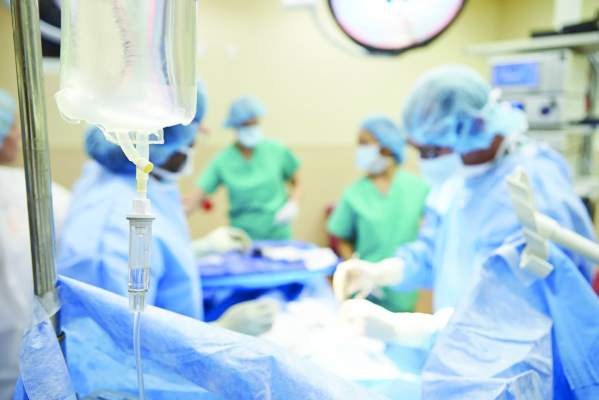REPORTING FROM MISS
LAS VEGAS (FRONTLINE MEDICAL NEWS) – Minimally invasive techniques have clear benefits for colectomy, including reduced hospital length of stay, less pain, faster return to work, and reduced incidence of adhesive small bowel obstructions. But the methods are underutilized, in part because they can be challenging to learn.
There are some tools and methods that can help surgeons perform surgeries laparoscopically, including hand-assisted laparoscopy and the use of single-incision laparoscopic colectomy (SILC). These methods were the subject of a talk at the Annual Minimally Invasive Surgery Symposium by Global Academy for Medical Education.
Between 2009 and 2012, a little over 30% of colon cancer cases in the United States and about half of diverticulitis cases were performed laparoscopically. The percentage of laparoscopic procedures ticked up slightly from 2009 to 2012, but only by a few percentage points. “The fact is, we’re just not doing [minimally invasive procedures],” Ian M. Paquette, MD, FACS , associate professor of surgery at the University of Cincinnati, said during his talk.
When a laparoscopic procedure proves challenging, one option is the hand-assist technique. The literature hasn’t been very supportive of the method, with one study of data from the American College of Surgeons National Surgical Quality Improvement Program showing that it offers no improvement in operation time, compared with standard laparoscopy, and that it has slightly higher complication rates ( J Gastrointest Surg. 2016 Nov;20[11]:1854-60 ). “They say you should do everything laparoscopically,” said Dr. Paquette.
But he believes that the hand-assist technique gets a bad rap because of selection bias. More difficult cases are done with the hand-assist approach, and tend to have worse outcomes. “[Hand assist] is awfully useful for some of these tougher cases,” said Dr. Paquette. In challenging cases, surgeons can convert a laparoscopic surgery to a hand-assist procedure rather than an open procedure, though this requires some practice in keeping your free hand away from the dissection.
One high-volume surgeon showed what happened over time when his practice employed hand-assisted laparoscopy for diverticulitis cases ( Dis Colon Rectum. 2014;57[9]1090-7 ). Initially, most cases were done with the hand-assist technique. Over time, that percentage dropped precipitously and the number that were performed laparoscopically rose sharply. Throughout the study period, the percentage of open procedures remained very low, dropping to almost zero near the conclusion. “They were able to keep their experience of open surgery quite low by using hand-assisted techniques to help with the tough cases of diverticular disease and get over that learning curve,” said Dr. Paquette.
In colon cancer, the study found that laparoscopic procedures hovered around 50%, while open and hand-assisted techniques tended to be around 20%. The higher incidence of open procedures was probably due to the desire of surgeons to be certain that the entire tumor has been excised. “If you’re in doubt, you don’t compromise on oncology. You do an open procedure if you need to,” said Dr. Paquette.
Another tool available to surgeons is single-incision laparoscopic colectomy, as opposed to conventional multiport laparoscopic colectomy. The method results in a very small incision, but can be challenging because the instruments are closer together and it is tricky when the surgeon has to cross the instrument, he said.
Dr. Paquette’s own group also looked at extraction in hand-assisted sigmoid colectomy, in which the surgeon went in laparoscopically, mobilized the colon laterally as would be done in an open procedure, and then performed the colectomy through a small extraction incision. The length of stay was about 15% shorter, there was a lower readmission rate, and gastrointestinal function returned more quickly ( Surg Endosc. 2016 Aug;30[8]:3567-72 ).
Can patients who previously underwent a midline laparotomy be treated laparoscopically? “The answer is possibly yes,” said Dr. Paquette. He noted one study that showed higher rates of minor morbidity, ileotomy, and longer length of stay with laparoscopic treatment ( Surg Endosc. 2015;29[3]537-42 ). “It’s a worth a try if you carefully plan where you’re going to go in through your ports, get in off the midline somewhere if you have to, and just take a look. If you have some adhesions of the omentum to the abdominal wall, it’s really no problem and you can proceed. If you have a frozen abdomen, just do the right thing and open the patient,” said Dr. Paquette.
When it comes to extraction options, Pfannenstiel incisions have the lowest rates of incisional hernias, at 1.9%, according to a survey of 2,148 cases at the Cleveland Clinic. The periumbilical midline incision had the highest frequency at 16.2% ( Dis Colon Rectum. 2016 Aug;59[8]:743-50 ).
“If I’m doing a laparoscopic sigmoid or a laparoscopic low anterior, I do prefer to do a Pfannenstiel incision if I can. If you think that you may need to convert that patient for some reason, don’t do the Pfannenstiel first – nobody wants that big T-shaped incision,” said Dr. Paquette.
Global Academy for Medical Education and this news organization are owned by the same parent company. Dr. Paquette has consulted for Ethicon.




